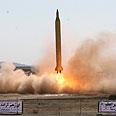
Iranian missile test
Photo: AP
WASHINGTON – The United States' missile defenses suffer from serious shortcomings, effectively leaving the US vulnerable to long-range missile strikes – and potentially an attack by Iran, a new report said Tuesday.
The 260-page report was complied by a National Research Council panel of experts, who have been analyzing the US' defense strategy for over two years.
Related stories:
- Panetta: If Iran builds bomb, US has only a year to act
According to the New York Times, the report was the first time that the National Research Council – which operates by proxy of the Congress – has weighed in on matters pertaining to the US' ability to battle a missile strike.
Former Lockheed Martin President David Montague, the panel’s co-chairman, noted that "For too long, the US has been committed to expensive missile defense strategies without sufficient consideration of the costs and real utility."
The 16-person panel, which included military experts, scientists, engineers, and weapons experts, recommended an overhaul "That would make the US' antimissile system far more effective."
The findings are believed to be a major blow to US President Barack Obama's strategy of downplaying the threat long-range missions pose to the US.
The report comes as concerns mount over Iran’s nuclear program. Tehran has often boasted that it possesses the technology to develop missiles that can strike US soil.
Currently, Tehran's missile arsenal, though rapidly growing, consists mostly of short and medium range projectiles. The new report looks ahead a decade or more to what it calls the “likely development” of Iranian missiles, designed to rain warheads down on the United States, the NYT said.
Since the 1980s, and the Reagan Administration, the US has been seeking to devise effective defenses against long-range missiles. Washington has so far spent more than $200 billion on such defense endeavors.
- Receive Ynetnews updates
directly to your desktop















